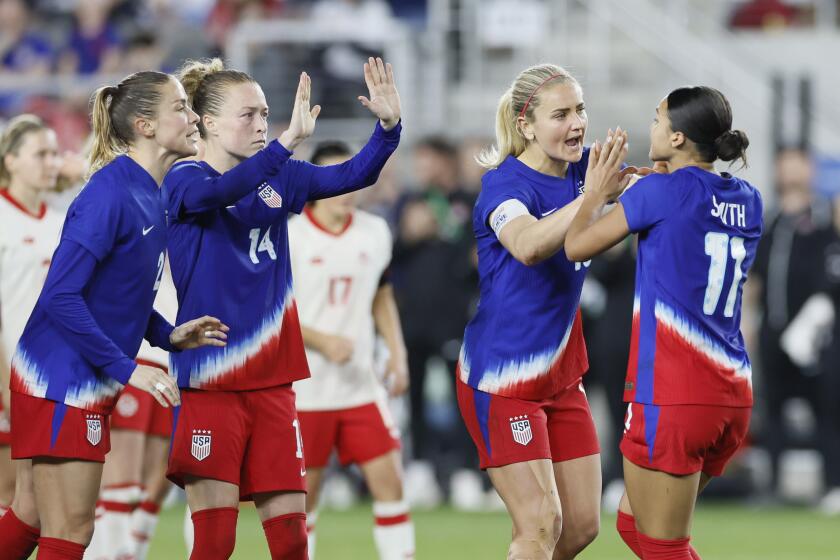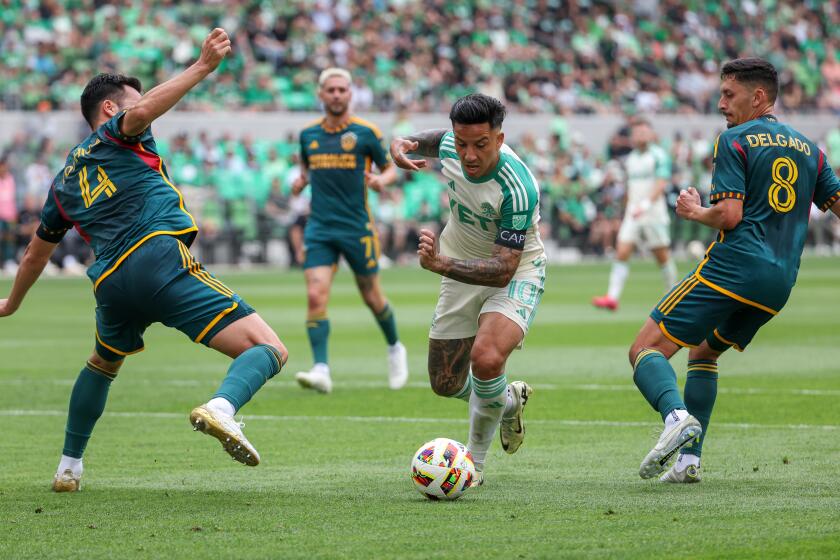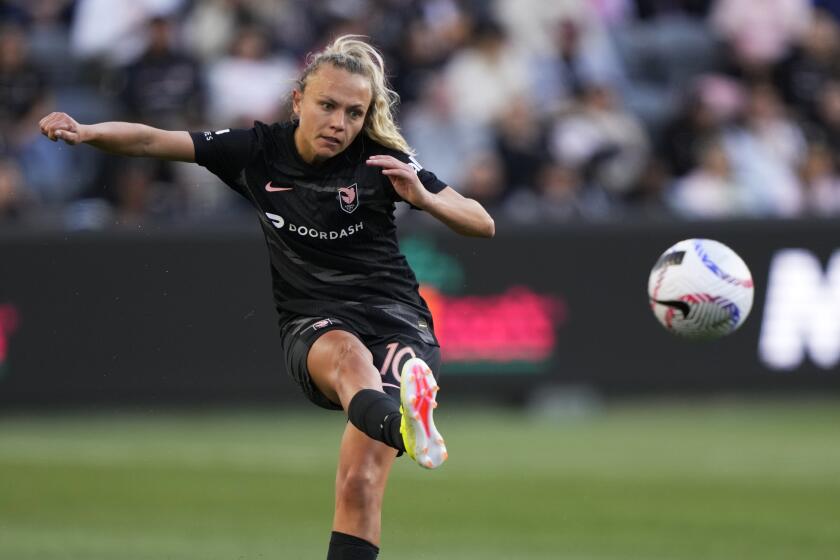She Makes It All Look Like a Snap
Brandi Chastain, Julie Foudy and Mia Hamm were trying to explain the other day just what it is that makes Alyson Kay Wagner so special.
And make no mistake, Wagner -- “Wags” to her teammates on the U.S. women’s national soccer team -- is special.
Players with world championships and Olympic gold medals on their resume don’t usually rave about up-and-coming youngsters. Support, yes, but rave, no. Not until they have proved themselves at the highest levels.
But Wagner, 22, is the exception.
Chastain, Foudy and Hamm were tripping over themselves in praise of a youngster who could be the key to U.S. hopes for retaining the Women’s World Cup in China next year and reclaiming the Olympic gold medal in Athens the year after.
She is that influential. She has that much potential.
Wagner, who led Santa Clara to its first NCAA women’s soccer championship last season, scoring the winning goal in the final against perennial powerhouse North Carolina, is a midfielder.
More specifically, she’s an attacking midfielder.
And, to make the point finer still, she is a playmaker, the closest thing soccer has to a quarterback.
Her ability to play the position with as much or greater skill than any of her predecessors on the national team is what sets her apart. On a team that has goal scorers aplenty, as the U.S. does, a player who knows how to get them the ball at just the right moment in just the right place with just the right touch is a rare find indeed.
Just listen to Hamm, who has scored more international goals than anyone else in history, man or woman:
“Aly can solve [defensive] pressure two ways: She can pass around it and she can dribble around it,” Hamm said. “But the other thing Aly gives us is she can serve balls with both feet and she can serve a variety of balls in terms of their texture. She can drive a ball, she can float a ball, she can bend a ball. She’s got the skill to do all of that.
“That kind of sophistication at her age is phenomenal. That was the first thing I noticed when she came on the team.”
That was in December 1998, when Wagner, then an 18-year-old from San Jose, made her U.S. debut, against Ukraine at UCLA.
Even at that young age, she was one of the last players cut from the roster just before the 1999 World Cup, which the U.S. won. The next year, at 19, she was an alternate on the U.S. team that won the silver medal at the Sydney Olympics.
Now, after battling through injuries in 2001, she is ready to make the midfield playmaking role her own. Foudy, who has played the position herself but now plays deeper in midfield, is astounded at what she sees.
“Aly is one of those players, it’s like sometimes you catch yourself watching her on the field,” Foudy said. “You’re like, ‘Wait, come on, play.’ Because she’s so much fun to watch. She’s so creative.”
And her potential?
“Huge,” Foudy said. “You can see it already. She’s one of those players a forward will run for anywhere because you know the ball is going to be at your feet wherever she goes. And you can see, when she gets the ball, the forwards just light up because they know.
“And she gets in behind defenses. The thing I love about her is she’s got everything. She’s technical on the ball, she can finish, she can serve the long ball, and she’s just so complete, and fun to play with. She’s got a good sense of humor and is always laughing on the field.”
Wagner, who has scored eight goals and assisted on 13 others in 31 games for the U.S. entering Saturday night’s CONCACAF Gold Cup championship match against Canada at the Rose Bowl, is also smart.
If soccer is a thinking woman’s game, then Wagner is the thinking woman. Listen to Chastain:
“There’s no doubt that Aly’s a very special player,” she said. “You have a player like that come around once every decade, perhaps.
“I think her greatest quality besides her passion for the game is that she sees it on a more complex level. I think Aly was very fortunate that she grew up in a soccer environment when she was very young.
“She had a [youth] coach, Phillipe Blin, at the Central Valley Mercury, where they taught those things. The game wasn’t just black and white. It had shades of gray. And I think Aly plays in those shades of gray at times. Where you think you’re going to see one thing and you get something else. I think that’s the complexity that she brings to the game.”
Wagner, who helped the Mercury win three national youth titles in a row, remains modest to a fault, long a trademark of the women’s national team.
“Whatever role they ask me to play, I’m willing to play it,” she said. “So I guess what I bring is a good attitude and the hard work that they need.”
And that ability to put the ball in exactly the place the forwards need it? Well, that’s thanks to Blin and to Jerry Smith, her coach at Santa Clara, and to the teammates around her, Wagner said.
“It’s just the spin you put onto the ball, so that [for] the person running onto it it’s easier to get a touch on it,” she said. “They don’t have to slow down or change their pace.”
Just like a quarterback connecting with a wide receiver in full stride.
*
(BEGIN TEXT OF INFOBOX)
Women’s Gold Cup
What: Finals of the CONCACAF Women’s Gold Cup tournament.
Where: Rose Bowl.
When: Saturday, 4:30 p.m. (third-place game, Mexico vs. Costa Rica) and 7 (championship game, U.S. vs. Canada).
What’s at stake: For the U.S. and Canada, regional prestige; both have qualified for the 2003 World Cup by winning semifinal matches. The winner of the Mexico-Costa Rica game will keep its World Cup hopes alive, qualifying for a playoff with the third-best team from Asia.






